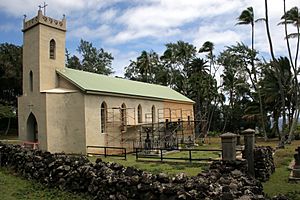Kalawao, Hawaii facts for kids
Quick facts for kids
Kalawao
|
|
|---|---|

St. Philomena Catholic Church, Kalawao
|
|
| Country | United States |
| State | Hawaii |
| County | Kalawao |
| Elevation | 66 ft (20 m) |
| Population
(2020)
|
|
| • Total | 0 |
| Time zone | UTC-10 (Hawaii-Aleutian) |
| ZIP Code |
96742
|
| GNIS feature ID | 360095 |
Kalawao (Hawaiian pronunciation: [kələˈvɐo̯]) is a special place on the Kalaupapa Peninsula. This peninsula is located on the island of Molokai in Hawaii. For many years, from 1866 into the early 1900s, Kalawao was a settlement for people with a serious illness called Hansen's disease (also known as leprosy). Thousands of people came to live here in a special community. The name "Kalawao" means "mountain-side wild woods" in the Hawaiian tongue.
Contents
Kalawao: A Historic Hawaiian Settlement
Kalawao is found on the eastern side of the Kalaupapa Peninsula. It was one of two main settlements on Molokai for people with Hansen's disease. The other settlement was Kalaupapa, located on the western side. Today, Kalawao is part of Kalawao County.
Why Kalawao Was Created
In 1866, the government of Hawaii decided to create a special place to help prevent the spread of Hansen's disease. They chose Kalawao for this purpose. A hospital, two churches, and many homes were built there for the people who came to live in isolation.
Important People at Kalawao
- Father Damien: A kind Catholic missionary from Belgium, Father Damien arrived in Kalawao in 1873. He dedicated his life to caring for the people living in the settlement. He helped them in many ways, offering comfort and support.
- Brother Joseph Dutton: In 1886, Brother Joseph Dutton came to Kalawao to help Father Damien, who was also ill. After Father Damien passed away, Brother Dutton started the Baldwin Home for Men and Boys in Kalawao. This home provided care for the residents.
Moving to Kalaupapa
In the early 1900s, the Hawaii Board of Health began moving patients from Kalawao to Kalaupapa. Kalaupapa was on the western side of the peninsula, about 3 miles away. It had a warmer, drier climate and was easier to reach by sea.
A hospital complex was built at Kalawao for research into Hansen's disease. From 1909 to 1913, the US Leprosy Investigation Station operated there. When this research center closed, the Kalawao settlement was no longer used for patients. Everyone moved to Kalaupapa.
Kalawao County Today
Even though Kalawao is on Molokai Island, it is not part of Maui County. It is its own separate county, called Kalawao County. It is the smallest county in the United States by land area. It is also the second smallest in population, with only a few residents.
What Remains at Kalawao
Today, only two buildings remain standing at Kalawao:
- Siloama Congregationalist Church: This church was built in 1866.
- St. Philomena Catholic Church: This church is connected to Father Damien.
Father Damien served the community for 16 years. He passed away from Hansen's disease in 1889 and was buried in the churchyard of St. Philomena. In 1936, his body was moved to Belgium. However, after he was recognized as a saint in 1995, part of his remains were returned to Hawaii. They were re-buried in his original grave at Kalawao.
Near these two historic churches, you can find Judd Park. This is a nice spot for a picnic, and it offers amazing views of Molokai's north shore.
See also
 In Spanish: Kalawao para niños
In Spanish: Kalawao para niños


